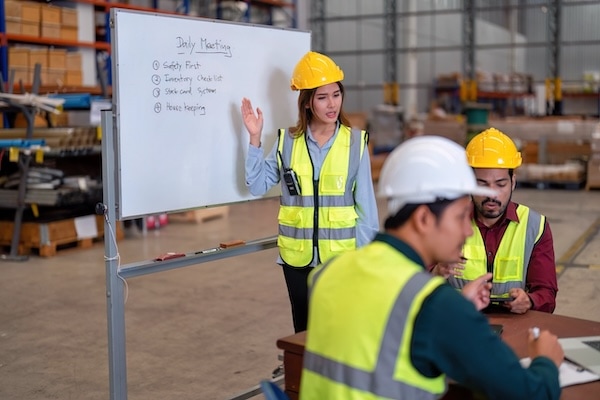Provided by: Three Sixty Safety
Falling and Flying Objects on the Floor
Objects falling from above can pose a serious danger, and you are at increased risk when others are working above you on the manufacturing floor. Employees on the manufacturing floor are also at risk of injury from flying objects when tools are pushed, pulled or pried and become airborne. Take this risk seriously; injuries resulting from flying objects can be severe, ranging from broken bones to paralysis to death.
Follow these guidelines to reduce your risk of injury from falling and flying objects.
General Precautions
- Always wear a hard hat and carefully maintain it. Excessive exposure to paint, some cleaning agents, sunlight and heat can all weaken hard hats. Wash them using warm water and never store them in the back window of your car.
- Stack materials to prevent sliding, falling and collapse.
When Working at a Height
- Do not work under moving loads.
- Barricade hazard areas and post warning signs of the dangers on the job site.
- Inspect hoists to make sure that wire rope, lifting hooks and chains are in good condition.
- Use toe boards, screens and guardrails on scaffolds to prevent objects from falling.
- Use debris nets, catch platforms or canopies to catch or deflect objects.
- Never exceed the lifting capacity of hoists.
- Secure tools and materials to prevent them from falling on others below.
- Never put hand tools in your pocket. They could slide out and injure a co-worker when you bend over.
Power Tool and Machine Precautions
- Wear safety goggles and face shields when operating machinery or tools that cause flying particles.
- Inspect tools to ensure that the protective guards are in good condition before each use.
- Do not use power tools unless you are properly trained on how to do so safely.
Air Compressor Precautions
- Reduce the amount of compressed air used for cleaning to 30 PSI.
- Only use this machine with the appropriate guarding and protective equipment.
Our Commitment to You
Your safety is our first priority. If you have any doubt about safety on-site, talk to your supervisor. Keeping you and your co-workers safe requires everyone’s cooperation.
This Safety Matters flyer is for general informational purposes only, and is not intended as medical or legal advice.







